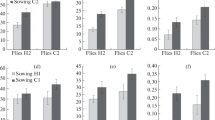Abstract
In high density cultivation of Spodoptera frugiperda (Sf9) cells in Grace's medium supplemented with FBS (fetal bovine serum) and yeastolate, amino acids were the primary limiting substrates while the carbon sources were not. Glutamine, methionine, and threonine were consumed rapidly during the cultivation. When cultures were supplemented with amino acids, yeastolate components other than amino acids became the secondary limiting substrates.
Similar content being viewed by others
References
Bedard C, Tom R, Kamen A (1993) Growth, nutrient consumption, and end-product accumulation in Sf-9 and BTI-EAA insect cell cultures: insights into growth limitation and metabolism. Biotechnol. Prog. 9: 625-624.
Clements AN, Grace TDC (1967) The utilization of sugars by insect cells in culture. J. Insect Physiol. 13: 1327-1332.
Drews M, Paalme T, Vilu R (1995) The growth and nutrient utilization of the insect cell line Spodoptera frugiperda Sf9 in batch and continuous culture. J. Biotechnol. 40: 187-198.
Ha SH, Park TH (1997) Efficient production of recombinant protein in Spodoptera frugiperda/AcNPV system utilizing silkworm hemolymph. Biotechnol. Lett. 19: 1087-1091.
Ha SH, Park TH, Kim S-E (1996) Silkworm hemolymph as a substitute for fetal bovine serum in insect cell cuture. Biotechnol. Tech. 10: 401-406.
Kim EJ, Park TH (1999) Reduction of FBS concentration through adaptation process in mammalian cell culture and addition of silkworm hemolymph in insect cell culture. J. Microbiol. Biotechnol. 9: 227-229.
King GA, Daugulis AJ, Faulkner P, Goosen MFA (1988) Growth of baculovirus-infected insect cells in microcapsules to a high cell and virus density. Biotechnol. Lett. 10: 683-688.
Kloppinger J, Fertig G, Fraune E, Miltenburger HG (1990) High cell density perfusion culture of insect cells for production of baculovirus and recombinant proteins. In: Spier AE, Griffiths JB, Meignier B, eds. Production of Biologicals from Animal Cells in Culture. Oxford: Butterworth-Heinemann Press, pp. 470-475.
Lee SH, Park TH (1994) Growth limiting factors influencing high density culture of insect cells in Grace's medium. Biotechnol. Lett. 16: 327-332.
Lee SH, Park TH (1995) Two-phase cultivation of insect cells for production of recombinant protein. Biotechnol. Techn. 9: 719-724.
Maiorella B, Inlow D, Shauger A, Harano D (1988) Large-scale insect cell-culture for recombinant protein production. Bio/technol. 6: 1406-1410.
Murhammer DW, Goochee CF (1988) Scaleup of insect cell cultures: protective effects of Pluronic F-68. Bio/technol. 6: 1411-1418.
Summers MD, Smith GE (1987) A Manual Method for Baculovirus Vectors and Insect Cell Culture Procedures. College Station: Texas A&M University.
Author information
Authors and Affiliations
Rights and permissions
About this article
Cite this article
Kim, J.H., Park, T.H. Substrates that limit high density cultures of Spodoptera frugiperda cells. Biotechnology Techniques 13, 425–429 (1999). https://doi.org/10.1023/A:1008964318308
Issue Date:
DOI: https://doi.org/10.1023/A:1008964318308



